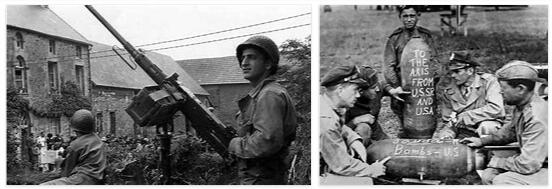With Wilson the reforms continued, until the outbreak of the First World War also involved the United States, which had also declared itself neutral. It was the German decision to wage submarine warfare to the bitter end that prompted Wilson, in April 1917, to declare war on Germany, which so brutally violated American neutrality. The underlying reasons for the United States’ entry into the war were, however, quite different: economic (loans and supplies made to the Entente), ethical-cultural (affinity with Great Britain and liberal regimes in general), realistic (protection of American interests against the danger of Germany’s victory). Proclaiming that the world “had to be made safe for democracy” and then enunciating the “14 points”, including the implementation of the principle of nationality, on which peace should have been founded, Wilson stamped his idealism on the Allied war, arousing enthusiasm and great expectations. But these were disappointed at the subsequent Peace Conference (1919) and Wilson, who, the first American president, had come to Europe, welcomed as a messiah, returned to America to face a bitter and futile battle. The Senate, in fact, refused the ratification of the peace treaty with Germany, because the pact establishing the he returned to America to face a bitter and futile battle. United States is a country located in North America according to TOPB2BWEBSITES.COM.
The Senate, in fact, refused the ratification of the peace treaty with Germany, because the pact establishing the he returned to America to face a bitter and futile battle. The Senate, in fact, refused the ratification of the peace treaty with Germany, because the pact establishing the League of Nations, Wilson’s favorite creature. The reaction against Wilsonism, even internally, brought the Republicans back to power in the 1920 elections, with WG Harding (1921-23), succeeded by C. Coolidge (1923-29) and Hoover (1929-33). The 1920s were those of the “return to normality” (the “normality” of the unbridled excessive power of big business), of a “prosperity” as overflowing as it is based on social inequality, prohibitionism, the advent of radio and cinema, the mass diffusion of the automobile, the illusion, as to foreign policy, of being able to return to isolationism .
The collapse of the New York Stock Exchange (October 1929) and the consequent “great economic crisis” overwhelmed prosperity, exposing its unhealthy character. The collapse of the economy was such that, after three years of crisis, it had come to the brink of collapse: industrial production dropped to one fifth, 17 million unemployed, hundreds of bankrupt banks, ruined savers, misery in the land of abundance and prosperity. The dimension of the crisis involved, with the economy, the social structures and the same moral convictions on which the United States was based: there was, on the whole, something profoundly wrong, which had to be corrected, not only with economic remedies, but also by establishing new relationships between the individual and society and leverages a strong moral impulse. This is the meaning of New Deal that the Democratic candidate for president in 1932, Franklin D. Roosevelt, proposed to the Americans, who gave him credit and elected him, and then re-elected him twice more, a unique case in American history. The long Roosevelt presidency (1933-45) highlighted the qualities of a great personality, an “aristocrat” (like his distant relative T. Roosevelt) sincerely democratic, capable of implementing his political choice with practical skill, even cunning, but with deep conviction about the goal to be achieved. The confidence he knew how to inspire was even more important in drawing America out of the crisis than so many New Deal measures, some of which were of an emergency nature, some were invalidated by the Supreme Court, some partially achieved their intended purpose. The essence of the New Deal, indeed, lies in having definitively introduced the principle of federal intervention in the United States, in having corrected “unbridled individualism” with the protection of the “common man”. In short, Roosevelt saved American democracy by means of reforms that transferred and integrated it on a social level. While the United States was engaged in the New Deal Nazi-fascist aggression in Europe and Japanese aggression in the Far East set the world towards a second war. Roosevelt, although late, realized the danger, but, also forced by internal reasons, he did not give concrete work to avert it.
After the war broke out, the Western democracies were overwhelmed and the Soviet Union was then attacked by Germany, Roosevelt, however, while proclaiming American neutrality, transformed the United States into the “arsenal of democracies since 1939, with the modification of the law of neutrality. “; an arsenal whose doors were then thrown open with the ” rent and loan ” law of March 1941. There was now no doubt about which field the United States had chosen; to actually drag them into war was the Japanese aggression of Pearl Harbor (December 7, 1941). Unlike in the First World War, the United States were the protagonists in this, militarily and politically. The difficult relations with the other two major allies, the similar one (Great Britain) and the antithetical one (the Soviet Union), were personally conducted by Roosevelt, among other things with the direct correspondence with W. Churchill and Stalin and the two conferences among the “big three”, in Teheran (end of 1943) and in Yalta (February 1945). Roosevelt believed he could maintain the agreement with Stalin even after the war, relying on his own personal prestige; but death struck him suddenly, on April 12, 1945, a few days before his victory in Europe. His successor, Truman (1945-53), a completely different man, attended the third and final conference of the “big three”, in Potsdam (July-August 1945), with an “ace up his sleeve”, the atomic bomb, the whose first, experimental explosion occurred on July 16. It is doubtful whether the launch of the atomic bombs on Hiroshima and Nagasaki (6 and 9 August) was decided above all to impress the Soviets or rather to hasten the surrender of Japan, which in fact took place immediately after.



